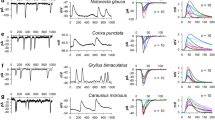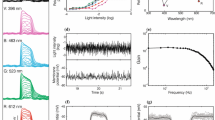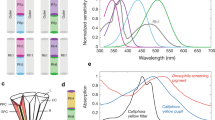Abstract
-
1.
From a comparison of the photoresponses and membrane properties of photoreceptors from 20 species of Diptera, we conclude that coding in the time domain is matched to the dictates of visual ecology. This matching involves the dynamics of phototransduction and the use of an appropriate mix of potassium conductances to tune the photoreceptor membrane.
-
2.
Rapidly flying, manoeuvrable diurnal Diptera from several families have fast photoreceptors, with corner frequencies (the frequency at which signal power falls by a half) of between 50 and 107 Hz. The ponderous and predominantly nocturnal tipulids have slow photoreceptors with fully light adapted corner frequencies of 16 to 19 Hz.
-
3.
Dark adapted fast photoreceptors have a lower gain (as indicated by lower noise levels), a lower sensitivity, and light adapt more rapidly than dark adapted slow photoreceptors. Fast cells also have much lower input resistances and shorter time constants.
-
4.
Fast photoreceptors rectify more strongly in the steady state because of a weakly inactivating delayed rectifier potassium conductance with fast and slow components of activation. Slow photoreceptors rectify less strongly in the steady state because their membrane properties are dominated by strongly inactivating outward currents with reversal potentials in the range — 80 to -90 mV.
-
5.
The differences between potassium conductances match the differing functional requirements of fast and slow photoreceptors. The non-inactivating delayed rectifier promotes the rapid response of fast cells by reducing the membrane time constant. This is an expensive strategy, involving large conductances and currents. Slowly flying nocturnal insects do not require a high speed of response. The potassium conductances in their slow photoreceptors inactivate to avoid costly and unnecessary ion fluxes.
-
8.
Both the dynamics of the photoresponse and photoreceptor membrane properties exhibit sexual dimorphism. Light adapted photoreceptors in the enlarged male dorsal eye of Bibio markii have a corner frequency of 42 Hz, compared with 27 Hz for cells in the smaller female eye. This difference in frequency response correlates with the male's higher spatial acuity and is accompanied by consistent differences in potassium conductance activation rate. We conclude that the divison between fast and slow cells is the product of cellular constraints, metabolic costs and the requirements of coding efficiency at different light levels and retinal image velocities.
Similar content being viewed by others
References
Alkon DL, Sakakibara M, Froman R, Harrigan J, Lederhendler I, Farley J (1985) Reduction of two voltage-dependent K+ currents mediates retention of a learned association. Behav Neur Biol 44:278–300
Autrum H (1950) Die Belichtungspotentiale und das Sehen der Insekten (Untersuchungen and Calliphora und Dixippus). Z Vergl Physiol 32:176–227
Autrum H (1984) Comparative physiology of invertebrates: hearing and vision. In: Dawson WW, Enoch JM (eds) Foundations of sensory science. Springer, Berlin Heidelberg New York, 1–23
Barlow RB, Chamberlain SC, Lehman HK (1989) Circadian rhythms in the invertebrate retina. In: Stavenga DG, Hardie RC (eds) Facets of vision. Springer, Berlin Heidelberg New York, 213–234
Burkhardt D, Motte I de la (1972) Electrophysiological studies on the eyes of Diptera, Mecoptera and Hymenoptera. In: Wehner R (ed) Information processing in the visual system of arthropods. Springer, Berlin Heidelberg New York, 147–153
Chittka L, Menzel R (1992) The evolutionary adapation of flower colours and the insect pollinators' colour vision. J Comp Physiol A 171:171–181
Coles JA, Schneider-Picard G (1989) Amplification of small signals by voltage-gated sodium channels in drone photoreceptors. J Comp Physiol A 165:109–118
Colyer CN, Hammond CO (1968) Flies of the British Isles (2nd ed). Warne, London New York
Edrich W (1991) Ein erstaunliches Reaktionsvermögen von Drohnen auf visuelle Bewegungsreize. Verh Dtsch Zool Ges 84:341
Fuortes MGF, Hodgkin AL (1964) Changes in time scale and sensitivity in the ommatidia of Limulus. J Physiol (Lond) 172:239–263
Hamdorf K, Hochstrate P, Höglund G, Burbach B, Wiegand U (1988) Light activation of the sodium pump in blowfly photoreceptors. J Comp Physiol A 162:285–300
Hardie RC (1979) Electrophysiological analysis of the fly retina I: Comparative properties of R1–6 and R7 and 8. J Comp Physiol 129:19–33
Hardie RC (1985) Functional organisation of the fly retina. Progr Sensory Physiol 5:1–79
Hardie RC (1991) Voltage-sensitive potassium channels in Drosophila photoreceptors. J Neurosci 11:3079–3095
Hardie RC, Voss D, Pongs O, Laughlin SB (1991) Novel potassium channels coded for by the Shaker locus in Drosophila photoreceptors. Neuron 6:477–486
Hateren JH van (1992) Theoretical predictions of spatiotemporal receptive fields of fly LMCs, and experimental validation. J Comp Physiol A 171:157–170
Hateren JH van (1993) Three modes of spatiotemporal processing by eyes. J Comp Physiol A (in press)
Howard J, Dubs A, Payne R (1984) The dynamics of phototransduction in insects: a comparative study. J Comp Physiol A 154:707–718
Howard J, Blakeslee B, Laughlin SB (1987) The intracellular pupil mechanism and the maintenance of photoreceptor signal to noise ratios in the blowfly Lucilia cuprina. Proc R Soc Lond B 23:415–435
Jansonius NM (1990) Properties of the sodium pump in the blowfly photoreceptor cell. J Comp Physiol A 167:461–467
Kirschfeld K (1983) Are photoreceptors optimal? Trends Neurosci 6:97–101
Land MF (1981) Optics and vision in invertebrates. In: Autrum HJ (ed) Handbook of sensory physiology, vol. VII/6B. Springer, Berlin Heidelberg New York, 471–592
Laughlin SB (1981) Neural principles in the peripheral visual systems of invertebrates. In: Autrum HJ (ed) Handbook of sensory physiology, vol. VII/6B. Springer, Berlin Heidelberg New York, 133–280
Laughlin SB (1989) The reliability of single neurons and circuit design — a case study. In: Durbin R, Miall RC, Mitchison G (eds) The computing neuron. Addison-Wesley, New York, 322–336
Laughlin SB, Weckström M (1989) The activation of a slow voltage-dependent potassium conductance is crucial for light adaptation in blowfly photoreceptors. J Physiol (Lond) 418: 200P
Laughlin SB, Howard J, Blakeslee B (1987) Synaptic limitations to contrast coding in the retina of the blowfly Calliphora. Proc R Soc Lond B 231:437–467
Lipetz LE (1971) The relation of physiological and psychological aspects of sensory intensity. In: Loewenstein WR (ed) Handbook of sensory physiology, vol. I. Springer, Berlin Heidelberg New York, 191–225
Lythogoe JN (1979) The ecology of vision. Oxford Univ Press, Oxford
Matic T, Laughlin SB (1981) Changes in the intensity-response functions of an insect's photoreceptors due to light adaptation. J Comp Physiol 145:169–177
O'Day PM, Lisman JE, Goldring M (1982) Functional significance of voltage-dependent conductances in Limulus ventral photoreceptors. J Gen Physiol 79:211–232
Pinter RB (1972) Frequency and time domain properties of retinula cells of the desert locust (Schistocera gregaria) and the house cricket (Acheta domestica). J Comp Physiol 77:383–397
Salkoff L, Baker K, Butler A, Covarrubias M, Pak MD, Wei A (1992) An essential ‘set’ of K+ channels conserved in flies, mice and humans. Trends Neurosci 15:161–166
Shaw SR (1975) Retinal resistance barriers and electrical lateral inhibition. Nature (Lond) 255:480–483
Shorrocks B (1972) Drosophila. Ginn, London
Souza JM de, Ventura DF (1989) Comparative study of temporal summation and response form in hymenopteran photoreceptors. J Comp Physiol A 165:237–245
Stavenga DG (1992) Eye regionalization and spectral tuning of retinal pigments in insects. Trends Neurosci 15:213–218
Vallett AM, Coles JA, Eilbeck JC, Scott AC (1992) Membrane conductances involved in the amplifcation of small signals by sodium channels in photoreceptors of drone honey bee. J Physiol (Lond) 456:303–324
Weckström M (1990) Voltage dependent potassium currents in locust photoreceptors. In: Elsner N, Roth G (eds) Brain — perception — cognition, Thieme, Stuttgart, 203
Weckström M, Hardie RC, Laughlin SB (1991) Voltage-activated potassium channels in blowfly photoreceptors and their role in light adaptation. J Physiol (Lond) 440:635–657
Weckström M, Juusola M, Laughlin SB (1992) Presynaptic enhancement of signal transients in the photoreceptor terminals in the compound eye. Proc R Soc Lond B 250:83–89
Williams DS (1980) Organisation of the compound eye of a Tipulid fly during the day and night. Zoomorphologie 95:85–104
Wong F (1978) Nature of light-conductance changes in ventral photoreceptors of Limulus. Nature (Lond) 276:76–79
Zeil J (1983a) Sexual dimorphism in the visual system of flies: the compound eyes and neural superposition in Bibionidae (Diptera). J Comp Physiol 150:379–393
Zeil J (1983b) Sexual dimorphism in the visual system of flies: the free flight behaviour of male Bibionidae (Diptera). J Comp Physiol 150:395–412
Zettler F (1969) Die Abhängigkeit des Übertragungsverhaltens von Frequenz und Adaptationszustand, gemessen am einzelnen Lichtrezeptor von Calliphora erythrocephala. Z Vergl Physiol 64:432–449
Author information
Authors and Affiliations
Rights and permissions
About this article
Cite this article
Laughlin, S.B., Weckström, M. Fast and slow photoreceptors — a comparative study of the functional diversity of coding and conductances in the Diptera. J Comp Physiol A 172, 593–609 (1993). https://doi.org/10.1007/BF00213682
Accepted:
Issue Date:
DOI: https://doi.org/10.1007/BF00213682




